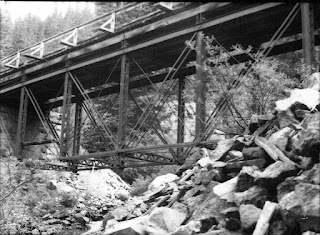In September of 1984 I graduated with an associate degree in Civil
Drafting. At the same time the 4th National Narrow Gauge Convention took
place in Denver. The following month we moved back to Colorado Springs.
 |
| Conoco no. 5 as of the late 1930s |
Technical drawing depends upon the ability to assimilate precision of detail into a graphic message. (They are often considered legal documents.) The ability to lineally plan ahead and the skill to execute the plan are essential to a successful job. Most importantly the drawings must be authentic and correct - after all, they involve the disposition of millions of Dollars. It also pays better than the T.V. repair job that I had while in school. These skills are valuable to the craft of model building and repair work as well.
 |
| In the 1920s some C&S Reefers may have been red |
The Narrow Gauge convention was the first major model railroading event I had attended. It was a wonderful and enlightening experience. Unlike the National Model Railroad Association conventions, model contests are judged by popular vote. I had entered a few local contests but never with any results. I entered a few models in the N.N.G.C. that year - with the same results. Maybe the models I entered were good, as time might prove, but because the contest wasn't "officially" judged the merits of any model were not directly meaningful. That's part of the reality of a popular vote. Years later we joked about entering Brio or Thomas "toy" trains as models to see how well they would do. After the convention I gave popular vote contests a lot of thought.
 |
| Refrigerator 597 was once a Tiffany car |
The move from Parker to Colorado Springs put an end to my layout building for a very long time. There would be an occasional shelf layout and even another module for the Slim Rail group but because of the space demanded by O scale there wasn't much opportunity to build an actual layout. We moved into a home that was as big as the one in Parker but there wasn't a space suitable to work with. What I had was a small work bench upon which to build models.
 |
| This plain coal car was built in 1902 |
The events of 1984 had a marked effect upon the direction of my hobby. With no real layout project all of my railroading efforts went into building models. My enjoyment of history was always a part of model railroading but under the circumstances I found myself indulging in the merger of model building and historical study. I realized each model could become a part of the overall historical narrative. This heightened the dedication to accuracy toward authentic representation of the prototypes. For the next decade modeling was a pursuit of this type of authenticity.
 |
| How this box appeared, when built in 1898 |
At that time there was no detailed narrative of the Colorado & Southern narrow gauge freight roster. There were listings of car classes and serial numbers with rough dates pertaining to the cars existence but there was no compiled history. Specific questions were difficult to answer.
It was no longer enough to just build models from general drawings and photos. These are essential but they are limited to the moment and plane on which they were created. My models had to become story tellers. In order to make that possible I
had to know how and where the real equipment came from, what they "did", and what happened to
them, There was an actual coal car 4319 (there still is). My model had to tell its story
as accurately as I could make
it.
 |
| The 550 series of reefers were the heaviest freight cars on the n.g. |
Perhaps that was a distracted notion but I saw it as worthwhile. I set out to be as thorough and accurate as the available information - where ever I could find it - could afford me. I like to believe many modelers benefited from these efforts and that a better understanding of the C&S evolved because of it.
The models shared in this post represent the individual stories that each of the prototypes had to tell. In future posts of this series I will try to share some of these and other stories; as well as that of the models themselves. Perhaps next time we will start with that funny looking car in the photo below.
 |
| The Chalk Creek Toboggan |
























